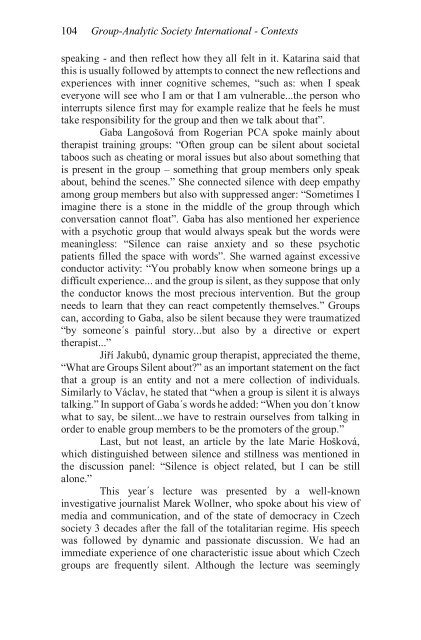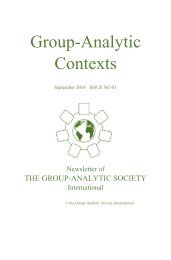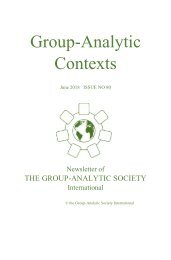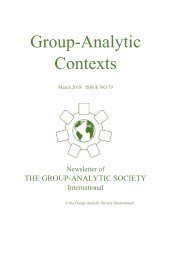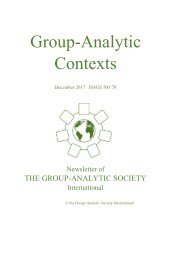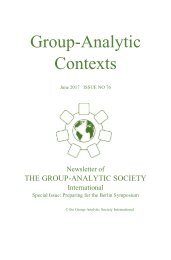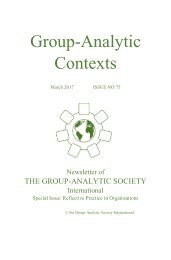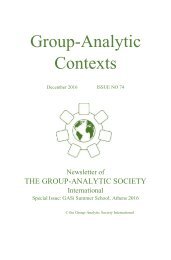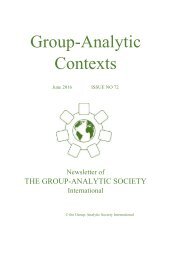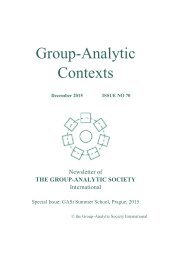Group Analytic Contexts, Issue 77, September 2017
Newsletter of the Group Analytic Society International
Newsletter of the Group Analytic Society International
Create successful ePaper yourself
Turn your PDF publications into a flip-book with our unique Google optimized e-Paper software.
104 <strong>Group</strong>-<strong>Analytic</strong> Society International - <strong>Contexts</strong><br />
speaking - and then reflect how they all felt in it. Katarina said that<br />
this is usually followed by attempts to connect the new reflections and<br />
experiences with inner cognitive schemes, “such as: when I speak<br />
everyone will see who I am or that I am vulnerable...the person who<br />
interrupts silence first may for example realize that he feels he must<br />
take responsibility for the group and then we talk about that”.<br />
Gaba Langošová from Rogerian PCA spoke mainly about<br />
therapist training groups: “Often group can be silent about societal<br />
taboos such as cheating or moral issues but also about something that<br />
is present in the group – something that group members only speak<br />
about, behind the scenes.” She connected silence with deep empathy<br />
among group members but also with suppressed anger: “Sometimes I<br />
imagine there is a stone in the middle of the group through which<br />
conversation cannot float”. Gaba has also mentioned her experience<br />
with a psychotic group that would always speak but the words were<br />
meaningless: “Silence can raise anxiety and so these psychotic<br />
patients filled the space with words”. She warned against excessive<br />
conductor activity: “You probably know when someone brings up a<br />
difficult experience... and the group is silent, as they suppose that only<br />
the conductor knows the most precious intervention. But the group<br />
needs to learn that they can react competently themselves.” <strong>Group</strong>s<br />
can, according to Gaba, also be silent because they were traumatized<br />
“by someone´s painful story...but also by a directive or expert<br />
therapist...”<br />
Jiří Jakubů, dynamic group therapist, appreciated the theme,<br />
“What are <strong>Group</strong>s Silent about?” as an important statement on the fact<br />
that a group is an entity and not a mere collection of individuals.<br />
Similarly to Václav, he stated that “when a group is silent it is always<br />
talking.” In support of Gaba´s words he added: “When you don´t know<br />
what to say, be silent...we have to restrain ourselves from talking in<br />
order to enable group members to be the promoters of the group.”<br />
Last, but not least, an article by the late Marie Hošková,<br />
which distinguished between silence and stillness was mentioned in<br />
the discussion panel: “Silence is object related, but I can be still<br />
alone.”<br />
This year´s lecture was presented by a well-known<br />
investigative journalist Marek Wollner, who spoke about his view of<br />
media and communication, and of the state of democracy in Czech<br />
society 3 decades after the fall of the totalitarian regime. His speech<br />
was followed by dynamic and passionate discussion. We had an<br />
immediate experience of one characteristic issue about which Czech<br />
groups are frequently silent. Although the lecture was seemingly


